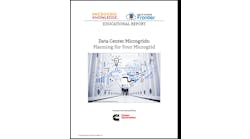Disaster Averted: 5 Lessons to Improve Emergency Responses in Your Data Center
In our years of managing data centers, we’ve witnessed almost every escalation imaginable. We know what it takes for technicians to confidently respond to emergencies and quickly take the correct steps for the situation.
Lesson #1: Create a plan for every possible scenario
Disaster planning starts with creating comprehensive emergency operating procedures (EOPs). Your EOPs should outline the desired response for every imaginable scenario, from life safety emergencies to failure of building support systems.
For example, if your computer room is equipped with a dry chemical abort switch, technicians must know when it is appropriate to use it. Software updates to fire suppression systems are another commonly overlooked area.
Lesson #2: Digitize EOPs to keep them current and accessible
An out-of-date manual can shut down systems. EOPs must be updated regularly to reflect changes to the data center infrastructure or emergency management safety plans. Digitizing this critical manual is the best way to ensure the most current version is accessible to all personnel — including those working remotely when a data center becomes inaccessible during an emergency.
Lesson #3: Never stop training
EOPs only avert disaster if your staff understands how to implement them. Consistent training prepares team members to thoughtfully take the proper steps in an emergency rather than giving into the human impulse to action. Avoid a culture of complacency through regular mock drills, repetitive training, and clear escalation paths.
Lesson #4: Tailor your training methods
New hires and experienced engineers need to be trained differently. One of the most common types of EOP training, scenario modules, enable trainees to practice response sequences for typical equipment failures and situations, such as a utility outage.
Scenario-based training is typically conducted with e-learning tools, meaning individuals can participate from anywhere. Virtual reality (VR)-based training offers a more immersive experience, and mock drills happen on-site in a team environment.
Lesson #5: Draw on experienced partners
An experienced facility management partner can provide valuable perspective and support when establishing your EOPs and conducting your training program. Because an external partner works with multiple data centers, they can provide insight into what works well (or doesn’t) in other facilities. They can also maintain communication with equipment manufacturers and designers to ensure emergency equipment is working properly at all times.
An experienced facility management partner can provide valuable perspective and support when establishing your EOPs and conducting your training program. Because an external partner works with multiple data centers, they can provide insight into what works well (or doesn’t) in other facilities. They can also maintain communication with equipment manufacturers and designers to ensure emergency equipment is working properly at all times.
A comprehensive emergency preparedness program can mean the difference between maintaining uptime and experiencing costly outages when equipment fails or disaster strikes. With exhaustive EOPs, regular training and experienced partners, your data center will be ready to withstand any emergency.







